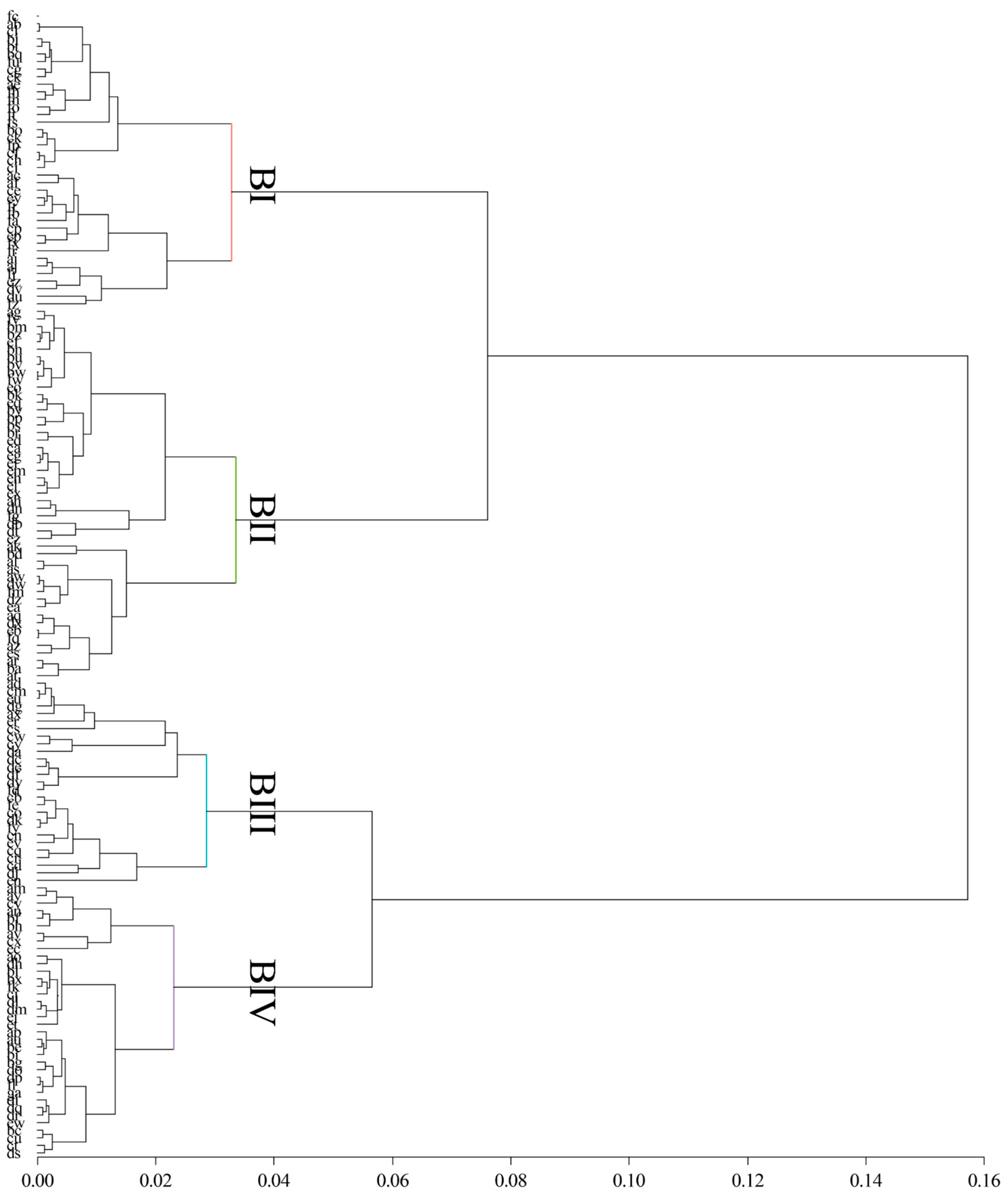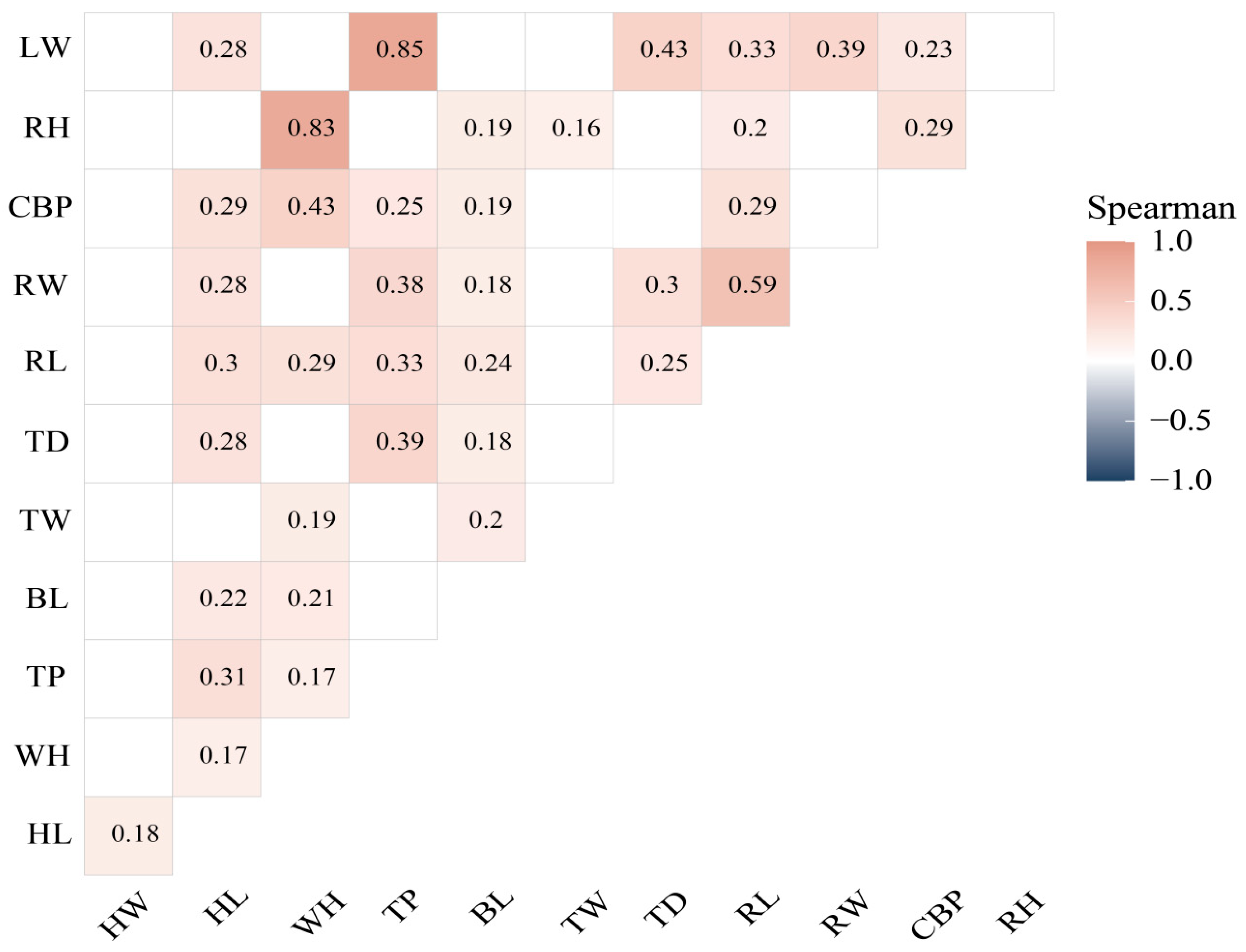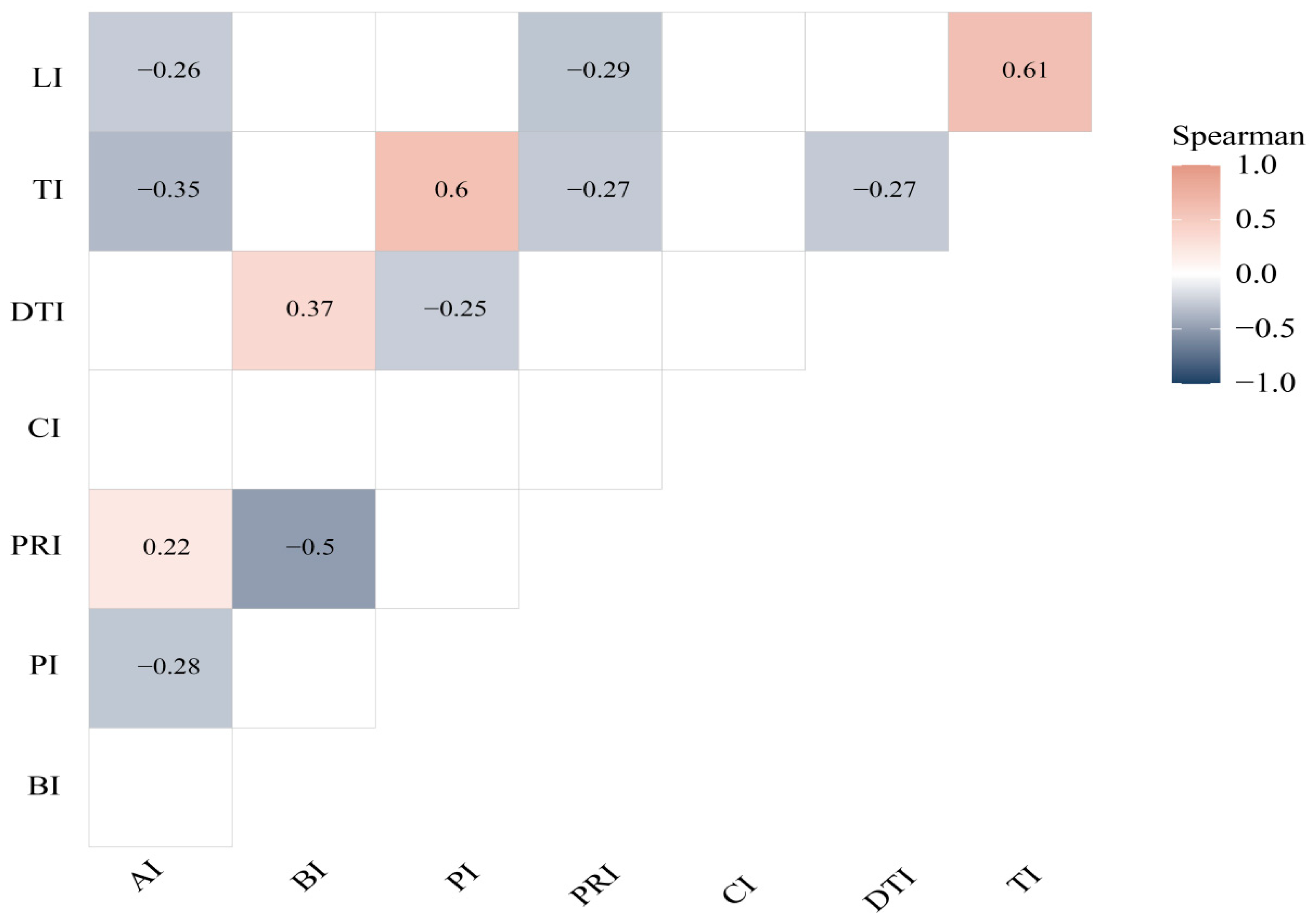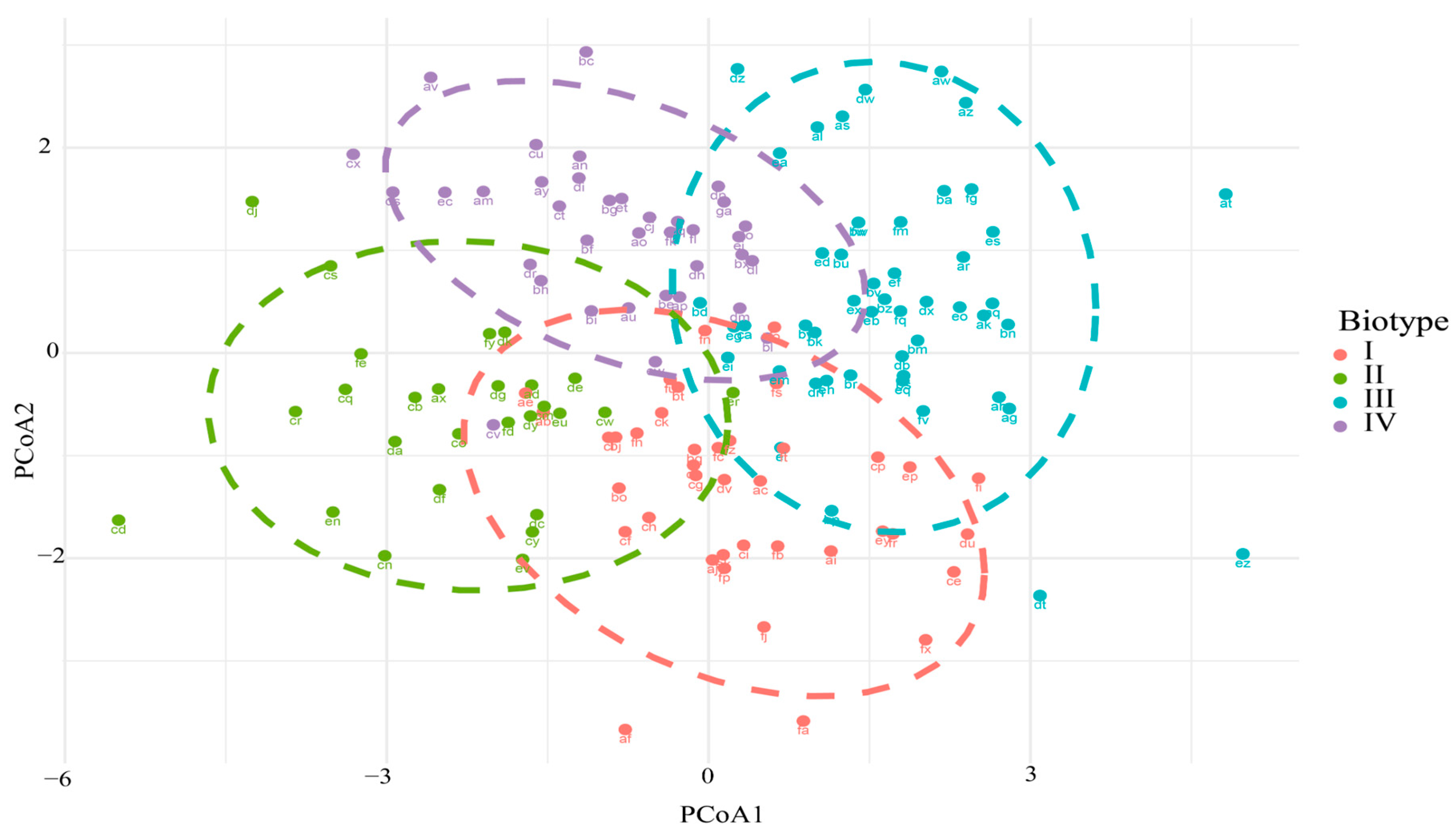Morphometric Characterization and Zoometric Indices of High-Andean Creole Cows from Southern Peru
Simple Summary
Abstract
1. Introduction
2. Materials and Methods
2.1. Ethical Considerations and Study Location
2.2. Morphometric Measurements and Zoometric Indices
2.3. Statistical Analysis
3. Results
3.1. Biotypes and Morphometric Measurements
3.2. Zoometric Indices
4. Discussion
5. Conclusions
Supplementary Materials
Author Contributions
Funding
Institutional Review Board Statement
Informed Consent Statement
Data Availability Statement
Acknowledgments
Conflicts of Interest
References
- Martínez, A.M.; Gama, L.T.; Cañón, J.; Ginja, C.; Delgado, J.V.; Dunner, S.; Landi, V.; Martín-Burriel, I.; Penedo, M.C.T.; Rodellar, C.; et al. Genetic Footprints of Iberian Cattle in America 500 Years after the Arrival of Columbus. PLoS ONE 2012, 7, e49066. [Google Scholar] [CrossRef] [PubMed]
- Yalta-Macedo, C.E.; Veli, E.A.; Díaz, G.R.; Vallejo-Trujillo, A. Paternal Ancestry of Peruvian Creole Cattle Inferred from Y-Chromosome Analysis. Livest. Sci. 2021, 244, 104376. [Google Scholar] [CrossRef]
- Arbizu, C.I.; Ferro-Mauricio, R.D.; Chávez-Galarza, J.C.; Vásquez, H.V.; Maicelo, J.L.; Poemape, C.; Gonzales, J.; Quilcate, C.; Corredor, F.-A. The Complete Mitochondrial Genome of a Neglected Breed, the Peruvian Creole Cattle (Bos taurus), and Its Phylogenetic Analysis. Data 2022, 7, 76. [Google Scholar] [CrossRef]
- FAO. El Segundo Informe Sobre La Situación de Los Recursos Zoogenéticos Mundiales Para La Alimentación y La Agricultura; FAO: Rome, Italy, 2015. [Google Scholar]
- Contreras, G.; Chirinos, Z.; Zambrano, S.; Molero, E.; Páez, A. Caracterización morfológica e índices zoométricos de vacas Criollo Limonero de Venezuela. Rev. Fac. Agron. Univ. Zulia 2011, 28, 91–103. [Google Scholar]
- Corredor, F.-A.; Figueroa, D.; Estrada, R.; Salazar, W.; Quilcate, C.; Vásquez, H.V.; Gonzales, J.; Maicelo, J.L.; Medina, P.; Arbizu, C.I. Genetic Diversity and Population Structure of a Peruvian Cattle Herd Using SNP Data. Front. Genet. 2023, 14, 1073843. [Google Scholar] [CrossRef] [PubMed]
- Estrada, R.; Corredor, F.-A.; Figueroa, D.; Salazar, W.; Quilcate, C.; Vásquez, H.V.; Maicelo, J.L.; Gonzales, J.; Arbizu, C.I. Reference-Guided Draft Genome Assembly, Annotation and SSR Mining Data of the Peruvian Creole Cattle (Bos taurus). Data 2022, 7, 155. [Google Scholar] [CrossRef]
- Encina Ruiz, R.; Saucedo-Uriarte, J.A.; Portocarrero-Villegas, S.M.; Quispe-Ccasa, H.A.; Cayo-Colca, I.S. Zoometric Characterization of Creole Cows from the Southern Amazon Region of Peru. Diversity 2021, 13, 510. [Google Scholar] [CrossRef]
- Rojas-Espinoza, R.; Macedo, R.; Suaña, A.; Delgado, A.; Manrique, Y.P.; Rodríguez, H.; Quispe, Y.M.; Perez-Guerra, U.H.; Pérez-Durand, M.G.; García-Herreros, M. Phenotypic Characterization of Creole Cattle in the Andean Highlands Using Bio-Morphometric Measures and Zoometric Indices. Animals 2023, 13, 1843. [Google Scholar] [CrossRef] [PubMed]
- Aguirre-Riofrio, E.L.; Abad-Guamán, R.M.; Uchuari-Pauta, M.d.L. Morphometric Evaluation of Phenotypic Groups of Creole Cattle of Southern Ecuador. Diversity 2019, 11, 221. [Google Scholar] [CrossRef]
- Cabezas Congo, R.; Barba Capote, C.; González Martínez, A.; Cevallos Falquez, O.; León Jurado, J.M.; Aguilar Reyes, J.M.; García Martínez, A. Biometric Study of Criollo Santa Elena Peninsula Cattle (Ecuador). Rev. Mex. Cienc. Pecu. 2019, 10, 819–836. [Google Scholar] [CrossRef]
- Hopper, R.M. Bovine Reproduction; John Wiley & Sons: Hoboken, NJ, USA, 2021; ISBN 978-1-119-60236-1. [Google Scholar]
- Vargas, G.; Schenkel, F.S.; Brito, L.F.; de Neves, H.H.R.; Munari, D.P.; Boligon, A.A.; Carvalheiro, R. Unravelling Biological Biotypes for Growth, Visual Score and Reproductive Traits in Nellore Cattle via Principal Component Analysis. Livest. Sci. 2018, 217, 37–43. [Google Scholar] [CrossRef]
- Demir, E.; Ceccobelli, S.; Bilginer, U.; Pasquini, M.; Attard, G.; Karsli, T. Conservation and Selection of Genes Related to Environmental Adaptation in Native Small Ruminant Breeds: A Review. Ruminants 2022, 2, 255–270. [Google Scholar] [CrossRef]
- Bartl, K.; Gómez, C.A.; Nemecek, T. Life Cycle Assessment of Milk Produced in Two Smallholder Dairy Systems in the Highlands and the Coast of Peru. J. Clean. Prod. 2011, 19, 1494–1505. [Google Scholar] [CrossRef]
- Alvarado-Bolovich, V.; Medrano, J.; Haro, J.; Castro-Montoya, J.; Dickhoefer, U.; Gómez, C. Enteric Methane Emissions from Lactating Dairy Cows Grazing Cultivated and Native Pastures in the High Andes of Peru. Livest. Sci. 2021, 243, 104385. [Google Scholar] [CrossRef]
- Villalobos-Cortes, A.; Carbono, M.; Rodriguez, A.; Arosemena, E.; Jaen, M. Phenotypic Characterization of the Guaymi Breed in Conservation Centers of Panama. Afr. J. Agric. Res. 2021, 17, 907–915. [Google Scholar] [CrossRef]
- Bertoni, A.; Fabio, N.; Daniel, M.-R.; Emilio, S.; Adolfo, Á.-M.; Patricia, M.-M.; Armando, M.-C.; Jesús, B.-G.; Legarreta, I.G. Similarities and Differences between River Buffaloes and Cattle: Health, Physiological, Behavioral and Productivity Aspects. J. Buffalo Sci. 2020, 9, 92–109. [Google Scholar] [CrossRef]
- Galukande, E.; Mulindwa, H.; Wurzinger, M.; Roschinsky, R.; Mwai, A.O.; Sölkner, J. Cross-Breeding Cattle for Milk Production in the Tropics: Achievements, Challenges and Opportunities. Anim. Genet. Resour. Génétiques Anim. Genéticos Anim. 2013, 52, 111–125. [Google Scholar] [CrossRef]
- Sañudo Astiz, C. Valoración Morfológica de Los Animales Domésticos, Madrid, España; Ministerio de Agricultura, Pesca y Alimentación (MAPA): Madrid, Spain, 2009; ISBN 978-84-491-0929-4.
- Lendechy, V.H.S.; Aguirre, R.L.; Palacios, F.M.; García, A.A.C.; Ahuja-Aguirre, C.; de Buen, L.L. Caracterización morfométrica e índices zoométricos del bovino criollo mixteco de Oaxaca, México. Rev. Bio Cienc. 2023, 10, 1–16. [Google Scholar] [CrossRef]





| Variables | BI | BII | BIII | BIV |
|---|---|---|---|---|
| HW | 19.34 ± 0.19 b | 19.74 ± 0.22 b | 19.67 ± 0.26 b | 20.5 ± 0.22 a |
| HL | 46.57 ± 0.35 b | 47.34 ± 0.39 b | 49.78 ± 0.46 a | 50.19 ± 0.40 a |
| WH | 112.13 ± 0.45 d | 119 ± 0.96 b | 122.11 ± 0.7 a | 115.25 ± 0.6 c |
| TP | 156.35 ± 0.7 b | 155.68 ± 0.8 b | 163.67 ± 1.0 a | 163.86 ± 0.86 a |
| BL | 130.0 ± 0.7 c | 134.66 ± 0.9 ab | 135.26 ± 1.0 a | 132.33 ± 0.9 bc |
| TD | 61.59 ± 0.6 bc | 61.52 ± 0.8 c | 68.29 ± 0.9 a | 65.25 ± 0.8 b |
| RL | 39.89 ± 0.4 d | 41.53 ± 0.5 c | 4507 ± 0.6 a | 43.17 ± 0.5 b |
| RW | 37.3 ± 0.6 b | 38.21 ± 0.7 b | 42.04 ± 0.8 a | 41.33 ± 0.7 a |
| CBP | 15.75 ± 0.2 c | 16.16 ± 0.1 b | 17.93 ± 0.2 a | 16.22 ± 0.1 b |
| RH | 114.37 ± 0.6 c | 125.82 ± 0.7 a | 124.37 ± 0.8 a | 118.08 ± 0.7 b |
| BW | 308.78 ± 6.52 a | 303.34 ± 7.4 a | 359.41 ± 8.79 b | 362.11 ± 7.6 b |
| Variables | BI | BII | BIII | BIV |
|---|---|---|---|---|
| AI | 2.99 ± 0.1 a | 3.23 ± 0.07 b | 2.68 ± 0.08 c | 2.73 ± 0.07 c |
| BI | 83.34 ± 0.7 b | 86.58 ± 0.75 a | 82.72 ± 0.89 bc | 80.87 ± 0.77 c |
| PI | 93. 57 ± 1.3 a | 92.17 ± 1.49 a | 93.29 ± 1.77 a | 96.03 ± 1.53 a |
| PRI | 86.51 ± 0.6 c | 89.23 ± 0.8 ab | 90.2 ± 0.9 a | 87.21 ± 0.8 bc |
| CI | 41.63 ± 0.5 a | 41.77 ± 0.6 a | 39.72 ± 0.7 b | 40.86 ± 0.6 ab |
| DTI | 10.08 ± 0.09 c | 10.39 ± 0.1 b | 10.96 ± 0.1 a | 9.9 ± 0.1 c |
| TI | 33.14 ± 0.5 bc | 31.92 ± 0.6 c | 34.44 ± 0.7 ab | 35.91 ± 0.6 a |
| LI | 35.5 ± 0.4 b | 34.69 ± 0.5 b | 36.92 ± 0.5 a | 37.49 ± 0.5 a |
| Df | SumOfSqs | R2 | F | p | |
|---|---|---|---|---|---|
| Biotype | 3 | 520.87 | 0.2895 | 19.962 | 0.0001 *** |
| Residual | 147 | 1278.59 | 0.711 | ||
| Total | 150 | 1799.47 | 1 |
Disclaimer/Publisher’s Note: The statements, opinions and data contained in all publications are solely those of the individual author(s) and contributor(s) and not of MDPI and/or the editor(s). MDPI and/or the editor(s) disclaim responsibility for any injury to people or property resulting from any ideas, methods, instructions or products referred to in the content. |
© 2025 by the authors. Licensee MDPI, Basel, Switzerland. This article is an open access article distributed under the terms and conditions of the Creative Commons Attribution (CC BY) license (https://creativecommons.org/licenses/by/4.0/).
Share and Cite
Ccalta, R.; Huayta Arizaca, R.F.; Salcedo Quispe, E.L.; Valverde, A.; Cucho Dolmos, H.C.; Canaza-Cayo, A.W.; Acuña Leiva, A.Y.; Estrada, R. Morphometric Characterization and Zoometric Indices of High-Andean Creole Cows from Southern Peru. Vet. Sci. 2025, 12, 782. https://doi.org/10.3390/vetsci12080782
Ccalta R, Huayta Arizaca RF, Salcedo Quispe EL, Valverde A, Cucho Dolmos HC, Canaza-Cayo AW, Acuña Leiva AY, Estrada R. Morphometric Characterization and Zoometric Indices of High-Andean Creole Cows from Southern Peru. Veterinary Sciences. 2025; 12(8):782. https://doi.org/10.3390/vetsci12080782
Chicago/Turabian StyleCcalta, Ruth, Rito Felipe Huayta Arizaca, Elvis Lizandro Salcedo Quispe, Anthony Valverde, Hernán Carlos Cucho Dolmos, Ali William Canaza-Cayo, Alex Yony Acuña Leiva, and Richard Estrada. 2025. "Morphometric Characterization and Zoometric Indices of High-Andean Creole Cows from Southern Peru" Veterinary Sciences 12, no. 8: 782. https://doi.org/10.3390/vetsci12080782
APA StyleCcalta, R., Huayta Arizaca, R. F., Salcedo Quispe, E. L., Valverde, A., Cucho Dolmos, H. C., Canaza-Cayo, A. W., Acuña Leiva, A. Y., & Estrada, R. (2025). Morphometric Characterization and Zoometric Indices of High-Andean Creole Cows from Southern Peru. Veterinary Sciences, 12(8), 782. https://doi.org/10.3390/vetsci12080782







